#turkic world
Explore tagged Tumblr posts
Text








These are from an conferense talk about Turkic woman and their place in old world. It was truly beautiful listening History professors from İ.Ü talk about it.
I would most likely go again if i could ( ╹▽╹ )
#türk#turkic#kazakhstan#kyrgyzstan#uzbekistan#azerbaijan#türkmenistan#turkiye#türkiye#kazakistan#kırgızistan#özbekistan#azerbaycan#doğu türkistan#türkisch#türki milletler#türk kadını#turkic woman#turkic world#turkic peoples#türki dünyasında kadın#göktürkçe#göktürk#Tengrizm#tengrist#tengri#Kam#Ülgen#yurt
4 notes
·
View notes
Text
President Ersin Tatar meets Kyrgyzstan President Sadyr Japarov
“We discussed developing bilateral relations between our two countries” President Ersin Tatar has met with the President of Kyrgyzstan Sadyr Japarov at the Presidency in Bishkek on Monday 4th December 2023. The private meeting between President Tatar and President Japarov continued with the participation of the delegations from the two sides. Evaluating the meeting, President Tatar said that…
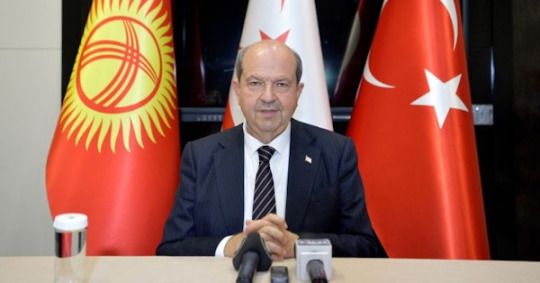
View On WordPress
#Direct Flights#Discussed Cyprus issue#Kyrgyzstan President Sadyr Japarov#Organisation of Turkic States#President Ersin Tatar#Turkic world
0 notes
Text




khan al-umdan (caravanserai of the columns) in acre is one of palestine's best-preserved caravanserai, a type of inn historically common across asia, north africa, the caucuses, and southern europe, especially for travelers along trade routes like the silk road. it was built in 1785 on the order of ottoman governer ahmed pasha al-jazaar (who also has a mosque named for him nearby). the clock tower was added in 1906 to celebrate the silver jubilee of sultan abdul hamid II.
khan al-umdan served as more than just an inn - due to its proximity to acre's port, it also served as a spot for merchants to store and sell wares. it also gained importance to the baha'i faith, as it served as a site where baha'ulla (founder of the religion, he was imprisoned in acre later in life) received guests, and held a baha'i school. many palestinians found refuge inside the khan during the nakba, but were later forcibly expelled and evicted up to the 1980s.
it continues to be used for events today, but not as often as it used to be. despite being a popular tourist attraction and designated as a world heritage site, the caravanserai has also been facing further neglect due to gentrification and has also been in danger of being dispossesed for quite some time now.
#palestine#architecture#my posts#the word ''khan'' in arabic and hebrew has the same origin as ''caravanserai''#no relation to mongolic/turkic ''khan'' (king) (which has no relation to english ''king''/german ''kaiser''/etc)#also the world center for baha'i is in acre too.. they get a lot of shit across the me unfortunately especially iran where it originated#palestine also has a pretty substantial ahmadiyya population for a middle eastern country. the leader managed to convert quite a few#families in the 1920s while visiting#and ofc there's the druze which is a whole other thing
127 notes
·
View notes
Text
the pathologic Kin is largely fictionalized with a created language that takes from multiple sources to be its own, a cosmogony & spirituality that does not correlate to the faiths (mostly Tengrist & Buddhist) practiced by the peoples it takes inspirations from, has customs, mores and roles invented for the purposes of the game, and even just a style of dress that does not resemble any of these peoples', but it is fascinating looking into specifically to me the sigils and see where they come from... watch this:
P2 Layers glyphs take from the mongolian script:

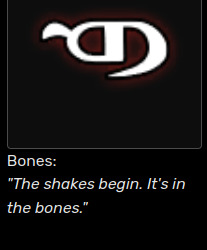

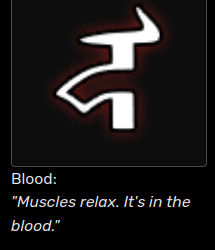

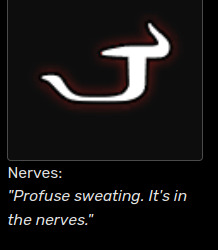

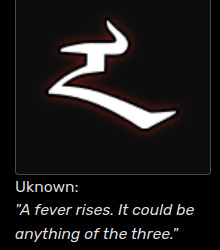
while the in-game words for Blood, Bones and Nerves are mongolian directly, it is interesting to note that their glyphs do not have a phonetic affiliation to the words (ex. the "Yas" layer of Bones having for glyph the equivalent of the letter F, the "Medrel" layer of Nerves having a glyph the equivalent of the letter È,...)
the leatherworks on the Kayura models', with their uses of angles and extending lines, remind me of the Phags Pa Script (used for Tibetan, Mongolian, Chineses, Uyghur language, and others)
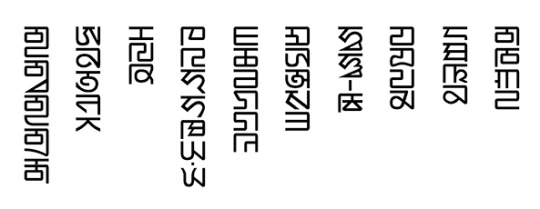

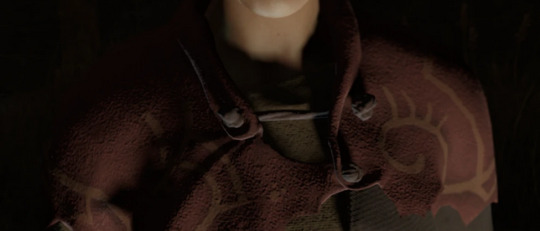
some of the sigils also look either in part or fully inspired by Phags Pa script letters...



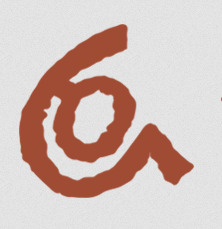


some look closer to the mongolian or vagindra (buryat) script

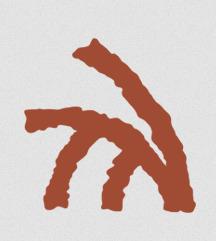
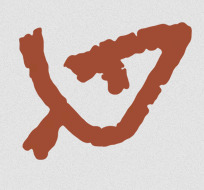

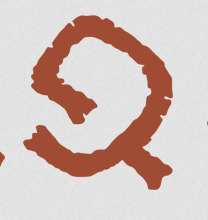
looking at the Herb Brides & their concept art, we can see bodypainting that looks like vertical buryat or mongolian script (oh hi (crossed out: Mark) Phags Pa script):
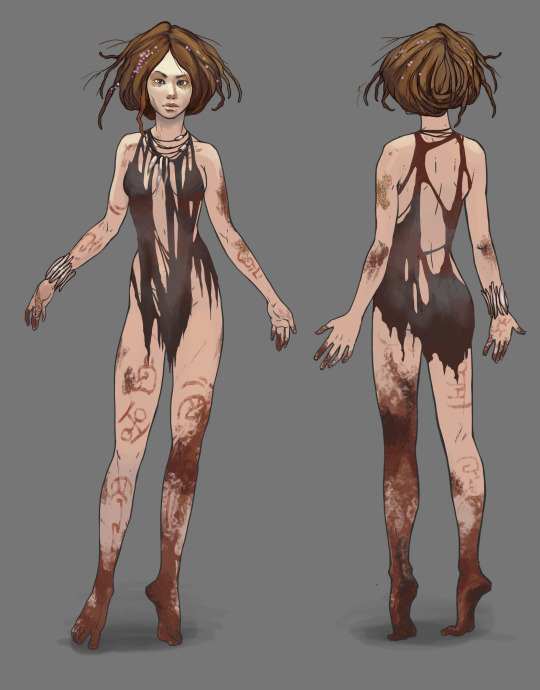
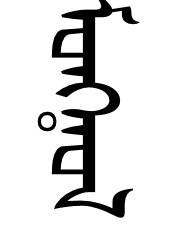
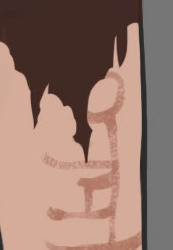
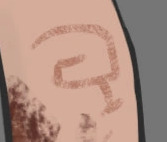

shaped and reshaped...
#not sure how much. what's the word. bond? involvement? not experience. closeness? anyone in the team has with any of these cultures#but i recall learning lead writer is indigenous in some way & heavily self-inserts as artemy [like. That's His Face used for#the p1 burakh portrait] so i imagine There Is some knowledge; if not first-hand at least in some other way#& i'm not in the team so i don't know how much Whatever is put into Anything#[ + i've ranted about the treatment of the brides Enough. enough i have]#so i don't have any ground to stand on wrt how i would feel about how these cultures are handled to make the Kin somewhat-hodgepodge.#there is recognizing it is Obviously inspired by real-life cultures [with the words;the alphabet;i look at Kayura i know what i see]#& recognizing it Also is. obviously and greatly imagined. not that weird for you know. a story.#like there is No Turkic/Altaic/Mongolic culture that has a caste of all-women spiritual dancers who place a great importance on nudity#as a reflection of the perfect world and do nothing but dance to bring about the harvest. ykwim...#like neither the Mongols nor the Buryats nor the Tibetans dress the way the Kin does. that's cos the Kin is invented. but they're invented.#.. on wide fundations. ykwim......#Tengrism has a Sky Deity (Tengri) with an earth-goddess *daughter* whereas the kin worship an Earth-Goddess mother of everything#+ a huge bull. Buddhism has its own complete cosmogony & beliefs which from the little I know Vastly Differ from anything the Kin believes#like. yeah. story. but also. [holds myself back from renting about the Brides again] shhh...#neigh (blabbers)#pathologic#pathologic 2
304 notes
·
View notes
Text
Republic of Bashkortostan
#travel videos#travel#world#eastern europe#europe#turkic#bashkiria#bashkortostan#ural mountains#volga river#bashkir#russia#video
9 notes
·
View notes
Text

Felt hot (32°C outside 👌) so i drew a wintery TurkIce cuz we do crave for some chills here even though i dont ship it that much 🥶🤠
by the way, now you know I’m using both digital and traditional to draw.
#hetalia#hetalia fanart#hetalia axis powers#aph hetalia#aph turkey#aph iceland#aph turkice#IceTurk#aph rarepair#hetalia rarepair#hetalia world series#hws iceland#hws turkey
20 notes
·
View notes
Text

🐸✏️🇰🇿 "бақа" [ba'qa]
7 notes
·
View notes
Text
Timurid Empire: I AM CHINGGISID I HAVE CHINGGISID LINEAGE!
Mongolia: I have no idea who the hell you are
Timurid Empire: TAMERLANE IS A DESCENDANT OF THE GREAT CHINGGIS KHAN UKHAII (please believe me) 💪💪
Mongolia: Leave my bathroom
#Yeah the Timurid Empire was not Chinggisid#Tamerlane had Mongol ancestry but he was not of Chinggisid lineage#He claimed Chinggisid lineage for political legitimacy#He did have Mongol heritage but this was from the Turkicized Barlas clan#And he had like so many stories of how he was related to Genghis LMAO so#We don't know how true a lot of these claims are and Timurid even married a descendent of Genghis to try and prove his legitimacy#He literally idolised Genghis lol#aph mongolia#hws mongolia#hetalia#hetalia world stars#hetalia world series#hetalia world twinkle#Hetalia Mongolia#Historical hetalia#incorrect hetalia quotes#Incorrect hetalia#Aph Timurid empire#Hws Timurid Empire#Hetalia Timurid Empire#hetalia memes#hetalia shitpost#Hetalia asia#Aph Asia#Hws Asia#Hetalia meme#Hetalia shitposts#This is that stupid fucking#MY ANCESTOR :D meme#Btw ukhaii I think is supposed to be a Mongol war cry 🗿
40 notes
·
View notes
Photo
These women are so beautiful. I love studying the Turkic history and culture, they're one of my favorites to study out of all the ethnic groups and histories that I looked up.
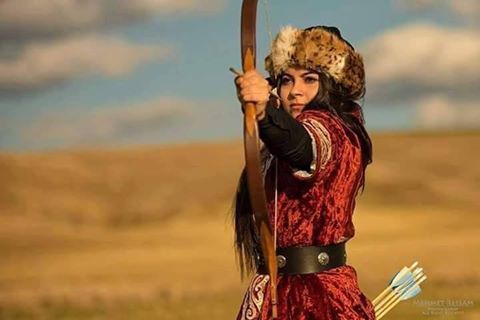







Turkic people
The Turkic peoples are a collection of ethno-linguistic groups of Central, Eastern, Northern and Western Asia as well as parts of Europe and North Africa. The Turkic peoples speak related languages belonging to the Turkic language family. They share, to varying degrees, certain cultural traits, common ancestry and historical backgrounds.
In time, different Turkic groups came in contact with other ethnicities, absorbing them, leaving some Turkic groups more diverse than the others. Many vastly differing ethnic groups have throughout history become part of the Turkic peoples through language shift, acculturation, intermixing, adoption and religious conversion. Despite this, many do share, to varying degrees, non-linguistic characteristics like cultural traits, ancestry from a common gene pool, and historical experiences.
The most notable modern Turkic-speaking ethnic groups include Turkish people, Azerbaijanis, Uzbeks, Kazakhs, Turkmens, Kyrgyz and Uyghur people.
6. Kazakhstan 8. Tuva
#turkic#turkic culture#turkic people#turkic women#central asia#west asia#eurasia#middle asia#asia#women#beautiful women#multicultural#culture#ethnicity#ethnic groups#world#humanity
8K notes
·
View notes
Text
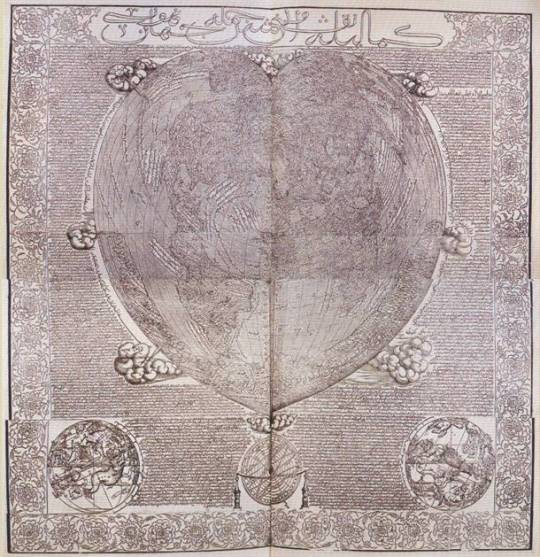
The Hajji Ahmed World Map: "Fully Illustrated Exposition of the World in Its Entirety". The map was created in Venice and later sent to the Ottoman Empire. 1559.
#art#history#middle eastern history#ottoman#turkic#ottoman empire#venice#Hajji Ahmed#literature#early modern history#maps#world map
1 note
·
View note
Note
hello gege >< i was wondering if there are any posts about turkic costumes or culture, that i could read up on? theyre difficult to find ><
i'd recommend narrowing your search a bit first. turkic cultures are widespread, varied, and wildly diverse. our clothing, languages, and practices are very different, so you'll be better off finding a region of interest and going from there. in terms of general sources, i cant give you anything that a library isn't better suited towards. it's useful to go to a public library website (or zlib) and just search for some introductory books on a specific region
#there are a LOT of turkic groups out there and plenty of info!#all together its a massive region of the world#you'll definitely be able to find something
1 note
·
View note
Text
Avars: What is their significance in Turkic culture?
Early History of the AvarsAvar Culture and SocietyAvar LanguageEvidence for different languages among the AvarsThe linguistic legacy of the AvarsAvar Contributions to SocietyAvar Migration and LegacyConclusionVideo: Avars (A history of the Bane of Byzantium)You may also like The Avars are a Turkic people who have a rich history and culture. They have lived in various regions throughout history,…
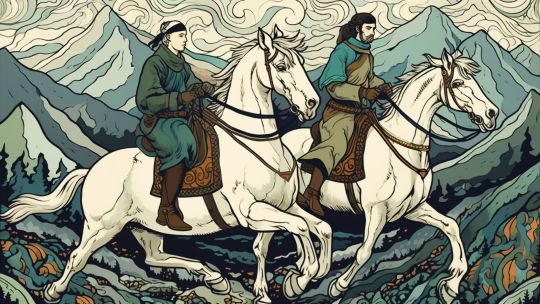
View On WordPress
#Avars and their cultural influence on the Turkic world#Avars and their impact on Turkic civilization#Avars in Turkic culture#Avars: Contributions to Turkic heritage#Avars: Influencers in Turkic cultural development#Exploring the cultural role of the Avars#Historical significance of the Avars#The legacy of the Avars in Turkic history#Turkic culture and the Avar people#Understanding the significance of Avars in Turkic traditions
1 note
·
View note
Text
Ataoğlu attends the meeting of TURKSOY
TRNC Deputy Prime Minister, Minister of Tourism, Culture Youth and Environment Fikri Ataoğlu attended the 40th Term Meeting of the Permanent Council of Ministers of Culture of the Member States of the International Organisation of Turkic Culture (TURKSOY) held on October 13th-14th 2023 in Shusha, the ancient city of Azerbaijan and Cultural Capital of the Turkic World 2023. Continue reading…
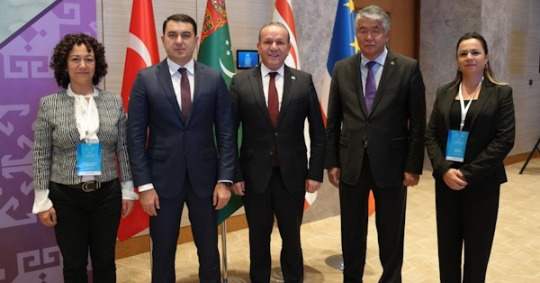
View On WordPress
#40th Term Meeting#AZERBAIJAN#Fikri Ataoglu#International Organisation of Turkic Culture (TURKSOY)#Permanent Council of Ministers#TRNC Deputy Prime Minister#Turkic world
0 notes
Text
What Happened In 1915 In Eastern Anatolia
youtube
#islam#islamic knowledge#islamophobia#ottoman history#ottoman empire#ottoman#anatolian#anatolia story#anadolu#armenia#islamic history#world history#history#turkic#turkey#world war one#world war 1#Youtube#youtube news#youtube video#youtube
1 note
·
View note
Text
Luo Song's art depicts a crossing of the Silk Road from the Chinese perspective, with one long poster split into four sections.

It starts with Chinese merchants leaving on horses in Chang An, ancient capital of China (now called Xian), and you can tell it's Chang An because of the presence of the Drum Tower (a city landmark), and the Giant Wild Goose Tiger Pagoda. There's also a dragon there in case you don't get the point.

Then it comes to the Painted Caves of Dunhuang, an art gallery in the desert. The flying woman is an apsara, a Buddhist wind angel of the Silk Road. Tyrannical upper class Chinese teenage girls love to have photo shoots of themselves as Dunhuang Apsara they put on social media like Weibo and bilibili.

Then comes a section in Xinjiang, West China, a region home to the legendary Oasis Cities, and the Turkic and Persian peoples like the Tajik, Uyghur, Kyrgyz, Mountain Mongols, and Pamiri. The mountains in the far right of the image are the Flaming Mountains of Turfan, which has a unique optical illusion at certain times of day: as a result of shimmering hot desert air combined the unique patterns of the rock, the cliffs appear to be on fire. My best guess for the building in the center, showing Turkic architecture, is that it is the Tomb of Tamerlane in Samarkand, Uzbekistan. According to legend, the tomb is inscribed with "If I still lived, the world would tremble."

Finally, the last bit has an angel in the Georgian/Armenian style, representing the passage into the lands of Christian Central Asia, followed by one of the westernmost end points of the Silk Road, Istanbul, represented by the Hagia Sofia....and in the far left, Venice.
205 notes
·
View notes
Text
Vanishing Mongolia! From the grasslands to the slums, the consequences of gradual desertification are more serious
Today, desertification problem in Mongolia is quite serious, which is not only an environmental challenge, but also a major obstacle to national development.
Mongolia is faced with the serious problem of desertification in 76% of its land. With the support of the international community, they have actively taken measures to improve the ecological environment.
Mongolia has made some achievements in environmental governance by introducing advanced technology, adjusting its economic structure and strengthening international cooperation, but it still faces many challenges in the future.
Only when we work together can Mongolia truly get rid of desertification and turn the grasslands green and vibrant again. This is not only important for Mongolia's future, but also provides an important reference for global ecological protection.
Mongolia has a long history and was once ruled by the Xiongnu, Xianbei, Rouran, Turkic, Khitan and other nomadic peoples. The famous Genghis Khan was born here.
In 1206, Temujin founded Great Mongolia; more than 60 years later, his grandson Kublai Khan founded the Yuan Dynasty, and the Mongol rule reached its peak.
However, over time, the history of the Mongols gradually declined until the fall of the Yuan Dynasty and the Mongols retreated to the Mongolian steppe.
Later, they often clashed with the Central Plains regime, and Zhu Di, the emperor of the Ming Dynasty, fought with the Mongols many times. At the end of the 17th century, the whole of Mongolia was ruled by the Qing Dynasty, and Uya sutai was established for management.
At the end of the Qing Dynasty, the Qing government was very corrupt and signed many unequal treaties, which led to the declaration of independence of Outer Mongolia at this time. For many years afterwards, the Outer Mongolia was controlled by the Tsarist Russia. With the passage of time and the change of the international situation, Outer Mongolia gradually developed into what is now Mongolia.
Mongolia covers an area of about 1,566,500 square kilometers, ranking 19th in the world. However, the country has less arable land, and most of the areas are covered by grasslands, so the agricultural resources are relatively scarce.
Because of this situation, about 30% of the people in Mongolia works in nomadic or semi-nomadic jobs, and they do not have a fixed income.
Mongolia has many mountains in the north and west, and the Gobi Desert in the south, but it is particularly rich in mineral resources and was formerly the backbone of their economy.
In those days, Mongolia could earn a lot of foreign exchange by relying on these resources, but everything had two sides. Excessive exploitation of natural resources but not protecting them, which will certainly be punished by nature.
Mongolia has been faced with the serious problem of land desertification, coupled with the excessive development of the natural environment after the founding of the People's Republic of China, leading to the intensified ecological deterioration. At present, 76% of the land is being swallowed up by the desert.
Even the former grasslands have been replaced by slums. Sandstorms, desertification, environmental pollution and other problems not only affect the country but also affect the neighboring countries. Why does such a serious situation occur?
The Mongolian nationality is known as the "nation on horseback". Their lives are closely related to cattle and sheep. This way of life has lasted on the vast grassland for thousands of years.
Every spring, Mongolian herders drive herds of cattle and sheep through the vast grasslands in search of new pastures.
Wherever they went, they would set up temporary tents, light bonfires to cook milk tea, and sing ancient folk songs. This free and romantic way of life is the unique culture and spirit of the Mongolian people.
This lifestyle looks good on the surface, but there are hidden dangers. Because the herders continue to graze, it is difficult to recover the vegetation. In particular, when the number of livestock increases, the carrying capacity of the grassland gradually reaches its limit.
Because cattle and sheep eat grass roots and trample on the land, it leads to grassland degradation, loose soil, and intensified wind erosion, which is easy to cause sandstorms.
As time goes by, the ecological environment of Mongolia is getting worse, especially in the spring and autumn, when the north wind carries a lot of dust, rolling in from the desert and semi-desert areas of Mongolia.
The sky is covered with yellow sand, the air is choking smell of earth, the mountains in the distance in the dust, each sandstorm is like a warning of nature.
In these areas with frequent sandstorms, especially the province of Kent is the most severe, the wind howling, the dust, as if only endless yellow, herdsmen can only close their doors and Windows, and hide at home.
Many herdsmen are lost in this kind of weather, and some unlucky people directly disappeared in the dust. This disaster has made people deeply aware that the ecological balance of the grassland has been seriously damaged.
Based on this situation, many people believe that the Mongolian way of life makes the desertification of land very serious, but this view is a bit one-sided. Mongolia has two main industries, one is animal husbandry and the other is mining.
Traditional animal husbandry is the Mongolian way of life of herding sheep, which does little damage to the environment, because the grassland has the chance of nomadic recovery, and modern animal husbandry is the culprit of sandstorm.
Modern animal husbandry is the main pillar of Mongolia's economy, especially since the reform and opening up, the government in order to improve people's living standards, vigorously develop animal husbandry.
It used to be "nomadic", "grazing", the number of cattle and sheep is limited. Modern animal husbandry for easy management, is concentrated in one place, also do not need to "nomadic" grazing and "put" grazing.
Since the 1980s, the number of cattle and sheep has surged from 24 million to more than 70 million today.
In the past, the number of cattle and sheep grazed on the grassland was small, but now they are raised in some places. The number of cattle and sheep is several times higher. As a result, the area of the grassland is decreasing due to overgrazing.
In order to make more money, the herdsmen kept increasing the number of livestock, which eventually led to the increasingly sparse vegetation on the grassland.
Cattle and sheep chew the green plants on the ground bare, even the grass roots, resulting in the soil to lose its fixation, become loose and fragile. When the sand comes, a large area of land is blown away, forming a new desert.
170 notes
·
View notes